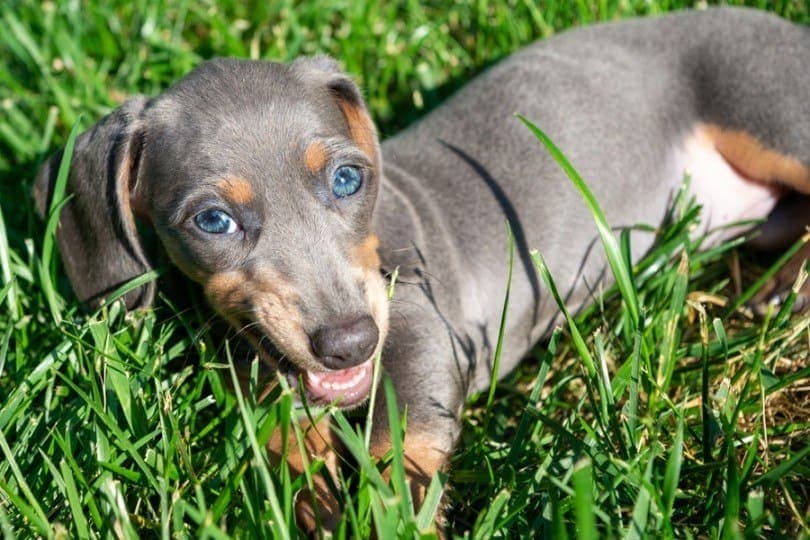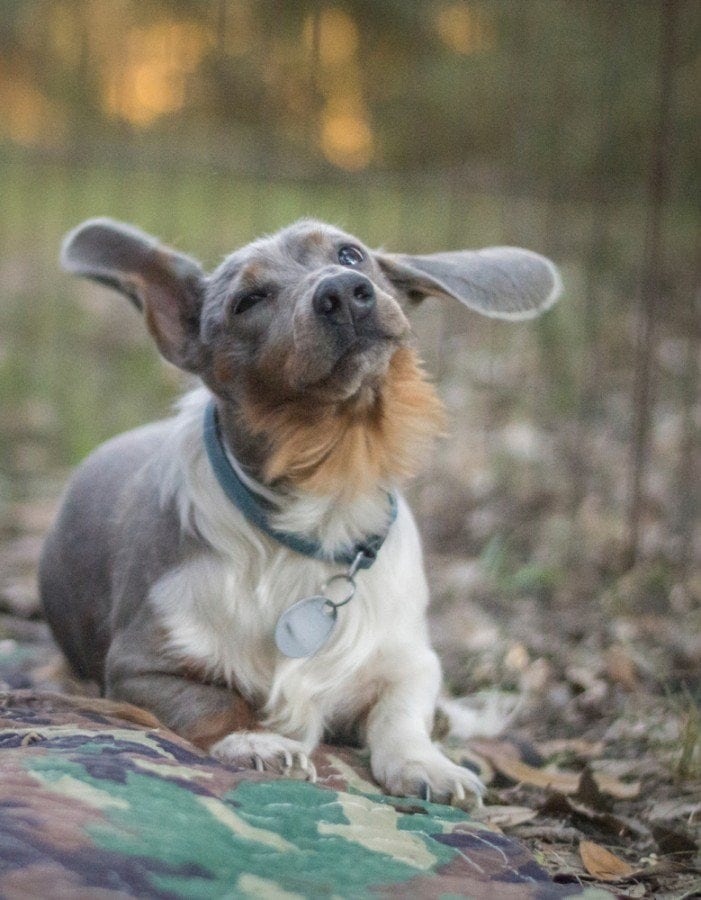Blue Dachshund: Breed Info, Pictures, Traits & Puppies

Updated on

Dachshunds are impressive dogs with amazingly good looks. They are long-bodied and short-legged, which is no doubt why they picked up the nickname “wiener dog” over the years. Canines come in coats of many colors, but this breed is at the high end of the scale. They come in over 15 color varieties, six coat patterns, and three coat lengths.
One of the most gorgeous of all is the lovely blue color. The color is a genetic dilution of the more traditional black and tan, meaning this isn’t technically a breed of dog on its own, but rather a special coloration of the Dachshund we all know and love. To achieve this color in the litter, both parents must be blue or carry the genetic trait in their makeup. While all Dachshund colors are lovely, this is arguably one of the most beautiful.
Blue Dachshund Puppies

A Dachshund ranks very high on the AKC popularity list, coming in at #12. You won’t find a shortage of puppies. However, finding a blue variation can take a bit more patience when searching, as this color is not in every litter.
While these Dachshunds are considered “blue”, they are a shade of gray with a bluish hue. Since they are a dilution of the black and tan coloring, they can be blue with patches of dulled tan or all blue. They never have black in their color patterns. Every Dachshund can come in three coat varieties: smooth, long-haired, and wire-haired.
Dachshunds have longer pointed snouts and floppy ears. Their bodies are elongated, their legs are short, and their tails point at a downward slope. They aren’t thick or stocky, but they do have noticeable muscle tone throughout their chest and legs.
If you opt to purchase from a licensed breeder, you will want to make sure the person is reputable. It is the best way to ensure the puppy is healthy. Backyard breeding is a common theme in the puppy world, and you won’t want to support the issue unknowingly.
Seeing the parents is a surefire way of knowing that you’re getting what they advertise. Not only is it a snapshot of your pup’s future, but you can also see how well they are cared for. If both parents are on the scene, you can gauge how big your puppy will be. You can also view the temperament firsthand to see if they have amiable personalities.
Dachshunds, as the whole breed is concerned, don’t get very big. But there are some differences you may not be aware exist. There are standard dachshunds as well as miniatures. While standard sizes are already quite small, they get even more petite. Miniature Dachshunds weigh an average of 11 pounds and stand 5 to 6 inches tall. The standard Dachshund, on the other hand, weighs an average of 16–32 pounds and stands 8 to 9 inches tall.
3 Little-Known Facts About the Blue Dachshund
1. The Dachshund was the first clone in Great Britain.
There was a contest conducted by South Korean tech firm, Saaom Biotech. Rebecca Smith entered the contest to have her 12-year-old dachshund Winnie cloned. She ended up winning the competition, and Mini Winnie came to fruition shortly after. The clone was created in a test tube from the original dog’s DNA.
Born in Seoul on March 30th, 2014, Mini Winnie came into the world to grow up with her original blueprint, Winnie. Shortly after Winnie’s death, Smith decided to allow Mini Winnie to reproduce. She gave birth to two healthy males in November of 2018 via emergency c-section.
2. The Nazis tried to teach Dachshunds to speak, spell, and write.
Interestingly, Hitler was all for animal rights. German soldiers formulated specialized learning for multiple dogs to teach them how to communicate with humans. The dogs were taught to “tap out” letters of the alphabet. As absurd as it may sound, he aimed to teach them to read, write, and even learn poetry.
A Dachshund, Kurwenal, was taught to speak by using barks to identify each letter. Reportedly, he told a biographer he would be voting for Hindenburg in an interview.
3. The breed was quite popular amongst famous artists.
There is quite a long list of famous artists throughout history who owned this breed in their lifetimes. Some of them include Pablo Picasso, Andy Warhol, David Hockney, Pierre Bonnard, Giacomo Balla, Waldi, and Earl Wettstein.

Temperament & Intelligence of the Blue Dachshund
When it comes to specific breeds, there will be certain likenesses. Of course, every dog will be their own individual, having its own quirks and eccentricities. However, when it comes to common denominators, it’s nice to know what to expect.
Personality and Temperament 🧠
When you look at a blue Dachshund, you’ll want to scoop them up and get all the doggy kisses they want to give you. But that might not happen the way you imagine it will. Dachshunds are spunky spitfires by nature. You may have one that is calmer or more hyper than others. However, on average, they are adventurous, bossy, and too clever for their own good.
Are These Dogs Good for Families? 🏡
While not inherently aggressive, they are a bit braver than they should be from time to time. They won’t take kindly to shenanigans, as bigger dogs or rowdy kids may get on their nerves. They can also be the kind of dog who bonds to only one person. Even though they may not mind others, they could be indifferent to all except their favorite human on earth.
Does This Breed Get Along with Other Pets? 🐶 😽
They can be highly persistent, leading to hard-headedness. While courageousness is an admirable trait, if you have a larger dog who doesn’t respond well to being bossed around, the blue Dachshund may not be the best playmate.
One thing is for sure, they love their people. They won’t hold back from snuggling up on your lap or beside your head at night. They like to be included in your activities and will always be the life of the party. Their entertaining personalities will fill you with happiness.
Things to Know When Owning a Blue Dachshund
Food & Diet Requirements 🦴
A wholesome, well-balanced diet is recommended. Because Dachshunds are prone to obesity, having a nutrient-rich, low-carb dish at mealtime will help them lead healthier, thinner lives. Be aware of caloric intake and do not give your dog puppy kibble longer than recommended.
Food high in calorie and carbohydrate content, as well as lots of fillers, can trigger obesity and allergens. This isn’t only true for dachshunds, but all breeds. Some are more sensitive than others. As a general rule, dog food should have 50% meat and 50% vegetables.
It will be a personal preference for both you and your dog whether you can buy dry kibble, wet, fresh, or dehydrated food.
Exercise 🐕
Of course, the animated Dachshund will benefit from physical exercise, but mental stimulation is a huge factor for them as well. They love interactive ways to spend time with you while catering to their zealousness. They will be happy to engage in yard games, tug-of-war, digging, or skipping around with other dogs.
Dachshunds do not make good running partners. Their short little legs tire easily, and excessive running can lead to joint and back problems. It is best to stick with long walks or toy play. If they don’t have a physical outlet, they can get bored, which will potentially lead to destructive habits that are hard to correct.
You must be careful when they play with other dogs, pets, or children. They are highly energetic during play and may not be mindful of their bodily limitations. Keeping them low to the ground and preventing them from climbing or straining their spines is fundamentally crucial.
Training 🦮
You will soon find out that every Dachshund has quite a mind of their own. They tend to be unapologetically themselves no matter what that entails. Learning how to mesh well with their personalities and learning styles is paramount.
Positive Reinforcement
You never want to try to bowl your Dachshund over. That isn’t going to end in your favor. Always reward good behavior. They will develop a healthier relationship with much more respect if they feel equally respected.
No Forceful Punishments
Dachshunds can be spiteful. If you are harshly punishing them, it can have an adverse reaction to what you’re trying to achieve. They may disobey simply because they don’t like the attitude you have shown concerning the subject.
Swatting, yelling, or other hostile acts are bad news for your connection. They won’t forget, and this can cause nervousness, poor manners, and even aggression.
All the Treats
While they can be quite finicky from time to time, they aren’t going to turn down a scrumptious treat. Always ration them correctly. However, when it comes to potty training or other learned skills, rewarding them with a delicious snack will always encourage them to repeat the action.
Grooming ✂️
Regardless of the type of coat your Dachshund has, they won’t shed excessively. Smooth Dachshunds need the least amount of grooming because their coat grows short and close to their bodies. Wire-haired Dachshunds need regular bruising, and once or twice a year, they should be stripped.
The long-haired variety of this breed will need the most amount of grooming to avoid tangles and mats in their fur. They should get more baths than the other two, although still not often, and blow-dried afterward.
Dachshunds also need special attention when it comes to their ears. Because Dachshunds have droopy ears that are relatively close to the ground, they are breeding grounds for mites, bacteria, and fungus. Clean them out to get rid of them.
You will also need to trim their nails a couple of times a month to keep them in good condition and brush their teeth daily for maximum dental hygiene.
Health and Conditions ❤️
Because of their elongated shape, it can put a lot of pressure on the back. Dachshunds are prone to what is called intervertebral disc disease. That causes the vertebrae to weaken and can eventually affect the spinal cord. Keeping your pet at a healthy weight and fully supporting the spine when holding them can help to prevent this.
They are prone to joint disorders like patellar luxation and hip dysplasia. They also have eye disorders like cataracts and dry eyes. More seriously, they can have Progressive Retinal Atrophy, which can lead to eventual blindness.
A healthy dachshund lives 12–16 years. This can be longer or shorter, depending on how healthy they are.
Male vs. Female
There are not many differences in the personality traits of the male and female Dachshund.
 Conclusion
Conclusion
Blue Dachshunds are a hard act to follow. They really have everything going for them in terms of distinctiveness, cuteness, and spunkiness. They are real head-turners who would make a lively addition to your home. Now that you know what to expect from your Dachshund experience, you can get started on your puppy search.
See also:
- Fawn (Isabella) Dachshund: Pictures, Facts, & History
- 12 Dachshund Colors, Patterns, & Markings (With Pictures)
Featured Image Credit: Icarus Avis, Pexels












